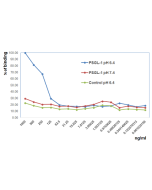Cookie Policy: This site uses cookies to improve your experience. You can find out more about our use of cookies in our Privacy Policy. By continuing to browse this site you agree to our use of cookies.
AdipoGen Life Sciences
TAPBPL (mouse):Fc (human) (rec.)

| Product Details | |
|---|---|
| Synonyms | Tapasin-related Protein; TAPASIN-R; TAP-binding Protein-like; Tapasin-like; TAPBPR; TAP Binding Protein-related |
| Product Type | Protein |
| Properties | |
| Source/Host | HEK 293 cells |
| Sequence |
The extracellular domain of mouse TAPBPL (aa 21-412) is fused at the C-terminus to the Fc portion of human IgG1. |
| Crossreactivity | Mouse |
| MW | ~80-90kDa (SDS-PAGE) |
| Purity | ≥95% (SDS-PAGE) |
| Endotoxin Content | <0.01EU/μg purified protein (LAL test). |
| Concentration | 1mg/ml after reconstitution. |
| Reconstitution | Reconstitute with 50μl sterile water. |
| Formulation | Lyophilized. Contains PBS. |
| Protein Negative Control | |
| Other Product Data |
UniProt link Q8VD31: TAPBPL (mouse) |
| Shipping and Handling | |
| Shipping | BLUE ICE |
| Short Term Storage | +4°C |
| Long Term Storage | -20°C |
| Handling Advice |
After reconstitution, prepare aliquots and store at -20°C. Avoid freeze/thaw cycles. Centrifuge lyophilized vial before opening and reconstitution. PBS containing at least 0.1% BSA should be used for further dilutions. |
| Use/Stability |
Stable for at least 6 months after receipt when stored at -20°C. Working aliquots are stable for up to 3 months when stored at -20°C. |
| Documents | |
| MSDS |
 Download PDF Download PDF |
| Product Specification Sheet | |
| Datasheet |
 Download PDF Download PDF |
T cells play critical roles in the adaptive immune system, protecting the human body against cancer, bacterial, viral, fungal, and parasitic infections. T cell immune response is tightly controlled by immune checkpoint proteins that negatively or positively regulate T cell response. Among the immune checkpoint proteins, the B7 family plays a key role in controlling immune responses and belongs to the immunoglobulin (Ig) superfamily. A number of B7 family ligands have been identified, such as B7-1 (CD80), B7-2 (CD86), PD-L1 (B7-H1), PD-L2 (B7-DC), B7-H2 [inducible T cell co-stimulator ligand (ICOS)], B7-H3, B7-H4 (B7x, B7S1), B7-H5 (VISTA) and B7- H6.
Because of the potential clinical applications of immune checkpoint proteins, there has been intense interest in identifying additional T-cell regulators. Recently, new antigen processing (TAP) binding protein-like (TAPBPL)/TAP binding protein-related (TAPBPR) molecule has been shown to share significant sequence similarity with some known B7 family members. TAPBPL protein is expressed on the surface of T cells, on antigen-presenting cells (APCs) including resting B cells, monocytes, macrophages, and DCs, as well as on some cancer cells including leukemia cells. TAPBPL behaves like other immune checkpoint proteins such as B7-H5 / VISTA or PD-L1 with a soluble recombinant version TAPBPL-Fc fusion protein that inhibits the proliferation and activation of CD4 and CD8 T cells in vitro and ameliorates autoimmune disease EAE in vivo. In contrast, treatment with anti-TAPBPL blocking antibody enhances antitumor immunity and inhibits tumor growth in vivo. Therefore, TAPBPL contains typical features of B7 family members, suggesting that it is a B7 family member or a B7 family-related molecule.








![VISTA [B7-H5] (mouse):Fc (human) (rec.)](https://adipogen.com/media/catalog/product/cache/60eb5af712bc93baae8d55513bd31b01/a/g/ag-40b-0164_biological_activity-250.png)